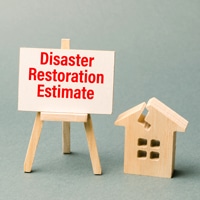Focus | Lead | Execute
Focus | Lead | Execute
Schedule a meeting
Writing winning restoration estimates goes beyond finding a number — you want to pump sales, increase closure rates, and improve gross profits. Your estimator will learn how to leverage technology and tighten up every aspect of the process, leading to higher profitability and better cycle time. After this course, your estimator will generate more revenue for every hour of work.

Operational goals start with a systematic scope, relying on good habits of damage documentation and assessment. Create estimates that are clear, concise, and accurate. Then use effective negotiating to come together quicker with adjusters, expediting the payment process and improving cash flow.
A reconfigured class structure, this program combines schedule flexibility and remote learning to offer a format everyone can attend. Comprised of 7 one-hour sessions held twice a week, your estimator will learn ways to pump sales, increase closure rates, and improve gross profits!
Develop complete and accurate scopes; Minimize price objections from customers and adjusters; Build trust and rapport with adjusters. Build trust with customers; Sell jobs through customer education; Provide timely estimates. Accurately price jobs; Understand production contingencies; Minimize supplements and negative change orders.

Damage Assessment
Scoping a Loss
Use of Technology
Proper On-Site Documentation
Salesmanship
T&M vs Unit Cost Formats
Line Items and Accurate Pricing
Tips and Tricks for Xactimate
Presenting the Estimate
Building Trust
Creating Customized Price Lists
Profitability
Class 1 | Introduction:
Estimators can get away from the basics of their job. This leads to a decrease in sales, closure rates, profits, and capacity. This session is an introduction to how we cover best practices in estimating and includes effective strategies, interactive discussions, and activities to improve your skills.
Class 2 | Standards:
Review photos of jobs to set standards that align with best practices, ensuring every estimator is working at the same high level. This guarantees all opportunities are assessed equally, creating consistent results. Photos allow participants to visually understand what each standard should look like.
Class 3 | Scoping:
Time and accuracy are of the utmost importance when scoping a loss. Maximizing efficiency on site can be achieved by developing a plan and establishing a routine. This routine will allow estimators to minimize their time on-site and develop an accurate scope.
Class 4 | Price and Profit:
Pricing in today’s market has become overly reliant on software companies and price guides. Learning how these price guides are developed is important so an accurate price can be determined for the scope of work performed.
Class 5 | Price and Profit 2:
Learn how to create customized and accurate price lists that reflect true costs. Doing so will result in larger margins on every job and help to provide feedback on true pricing in your area.
Class 6 | Adjuster’s Viewpoint:
It’s time to utilize and package all the tools provided in earlier sessions so adjusters will be willing and able to come to agreement, which will expedite the payment process. In short, get paid faster!
Class 7 | Project Managers:
Now that the estimating portion is complete, the hand-off to project management relies on accurate and thorough information and communication. We will help you define everyone’s roles and responsibilities.
minimize time on site
write more-profitable estimates
create more-accurate scopes
come to quicker agreements with adjusters
increase capacity
expedite the payment process
The information in this program was beneficial
100%
Would you recommend this program to others
99%
Per attendee
CECs
7 credit hours – IICRC
Do you want us to help you scale your business?
Our office
7026 Mears Gate Dr NW
North Canton, OH 44720
Mon-Fri: 8:00 – 5:00 ET
Call us
330 966 0700
Drop us a line
[email protected]